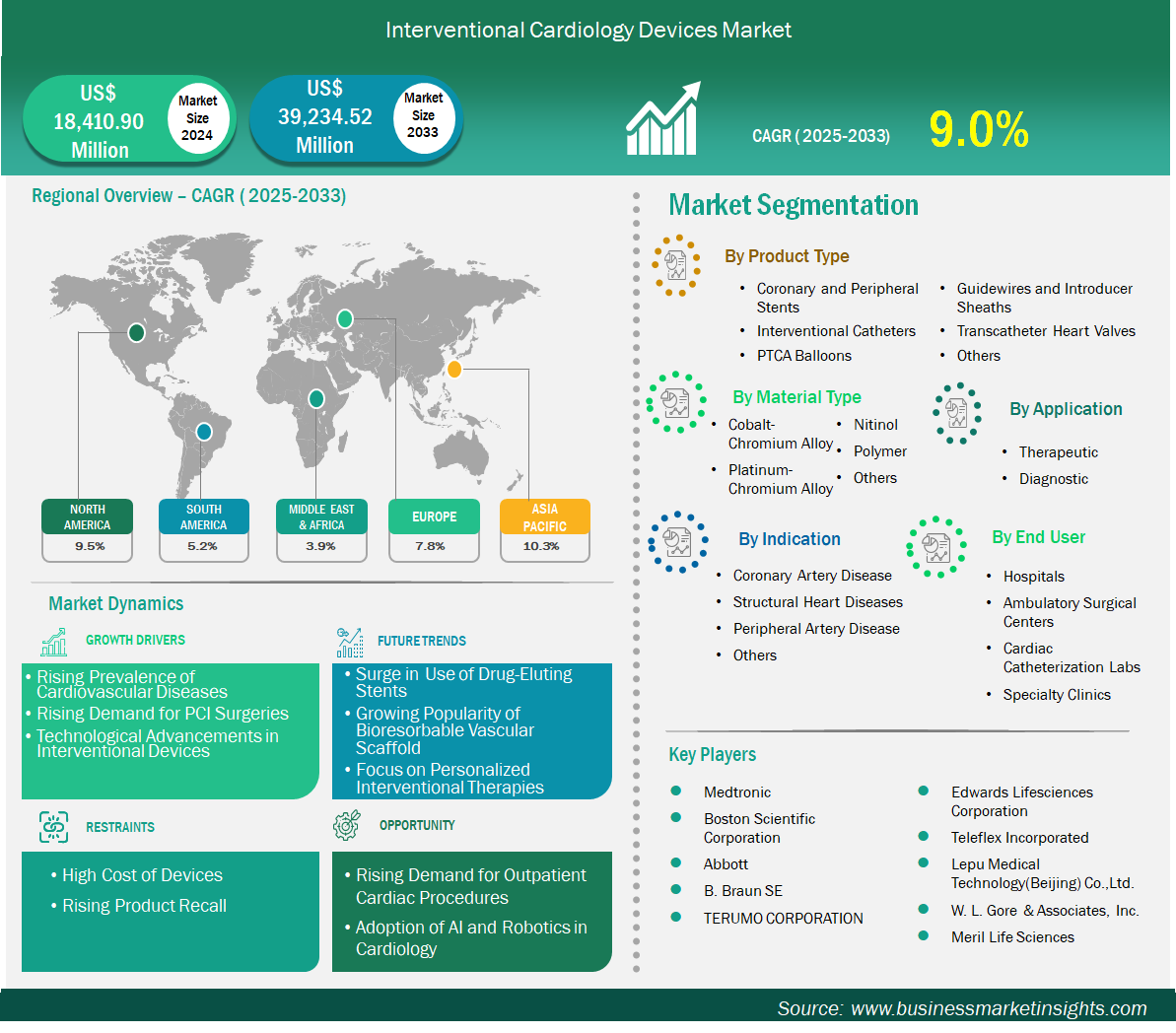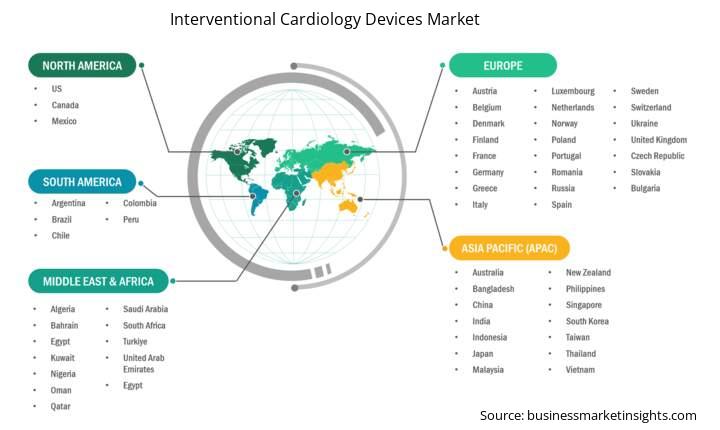The interventional cardiology devices market size is expected to reach US$ 39,234.52 million by 2033 from US$ 18,410.90 million in 2024. The market is estimated to record a CAGR of 9.0% from 2025 to 2033.
The interventional cardiology devices market focuses on medical tools used in minimally invasive procedures to treat heart problems, especially congested or narrowed arteries. These devices include stents, balloons, guidewires, catheters, and imaging systems that help doctors open clogged arteries and restore blood flow without the need for open-heart surgery. These procedures, such as angioplasty and stent placement, offer quicker recovery times, fewer complications, and shorter hospital stays.
The market is growing steadily due to the rising number of people with heart disease, an aging population, and a strong shift toward minimally invasive treatments. Novel technologies such as drug-eluting stents, bioabsorbable scaffolds, and advanced imaging tools are making procedures harmless and more effective. Robotic systems and AI-based tools are also improving accuracy and outcomes.
However, there are still some challenges. These include high device costs, strict approval processes, and limited insurance coverage in some countries. There’s also a risk of problems such as blood clots or artery re-narrowing. Nonetheless, with better access to healthcare in developing countries and more cardiac centers being built, the future of this market looks promising.

Key segments that contributed to the derivation of the interventional cardiology devices market analysis are product type, material type, application, indication, and end user.
Rising Prevalence of Cardiovascular Diseases
Lifestyle changes such as reduced physical activity, unhealthy eating habits, and rising stress levels have contributed to a steady increase in heart-related conditions. In particular, coronary artery disease, heart attacks, and high blood pressure are being diagnosed more frequently, both in urban and rural populations. This growing health burden has created a need for faster, safer, and more accessible treatment options.
For instance, according to an article published in January 2024, by Global Heart, an open-access journal, cardiovascular diseases (CVDs) are the leading cause of mortality globally, responsible for a significant number of deaths and disabilities. In 2021 alone, CVDs accounted for 20.5 million deaths, comprising approximately one-third of all global deaths.
As more people develop heart conditions, the number of such procedures performed in hospitals and specialized centers continues to increase. With cardiovascular diseases becoming more widespread, the demand for interventional cardiology devices is growing steadily, making this a key driver for market expansion.
Rising Demand for PCI Surgeries
Percutaneous Coronary Intervention (PCI), commonly known as angioplasty with stent placement, has firmly established itself as one of the most widely utilized procedures for treating blocked coronary arteries. Its inherently minimally invasive nature, eliminating the need for open surgery, offers significant advantages such as faster patient recovery times and substantially reduced hospital stays. This growing awareness among both patients and physicians regarding its safety, effectiveness, and efficiency has catalyzed a notable shift in preference toward PCI over traditional coronary artery bypass grafting (CABG), particularly for eligible cases.
The market is fueled by the increasing global prevalence of coronary artery disease, an aging population, and unhealthy lifestyles, more patients require this minimally invasive treatment. PCI is the most common procedure to treat blocked coronary arteries. Each surgery necessitates the use of a wide range of devices, including coronary stents, angioplasty balloons, and guide catheters. Consequently, the increasing volume of PCI procedures directly and proportionally drives the consumption and market growth of these essential medical devices.
By product type, the interventional cardiology devices market is segmented into coronary and peripheral stents, interventional catheters, PTCA balloons, guidewires and introducer sheaths, transcatheter heart valves, and others. The coronary and peripheral stents segment dominated the market in 2024. They're the primary treatment for coronary artery disease, which is highly prevalent. Technological advancements in drug-eluting stents have improved patient outcomes and boosted their use.
By material type, the interventional cardiology devices market is segmented into cobalt-chromium alloy, platinum-chromium alloy, nitinol, polymer and others. The cobalt-chromium alloy segment dominated the market in 2024. It offers superior radial strength and thin struts, enabling the creation of advanced stents that are both strong and flexible. It's also radiopaque, making it visible during procedures.
By application, the market is segmented into therapeutic and diagnostic. The therapeutic segment held a larger share of the market in 2024. The rising global prevalence of cardiovascular diseases drives demand for treatments, not just diagnostics. These devices offer minimally invasive options with short recovery times, which patients prefer.
By indication, the market is segmented into coronary artery disease, structural heart diseases, peripheral artery disease, and others. The coronary artery disease segment held the largest share of the market in 2024. It's the most common type of heart disease globally and the leading cause of death. This widespread prevalence creates a massive patient pool requiring intervention with devices like stents and catheters.
By end user, the market is segmented into hospitals, ambulatory surgical centers, cardiac catheterization labs, and specialty clinics. The hospitals segment held the largest share of the market in 2024. Hospitals have the advanced infrastructure, skilled cardiologists, and large patient volumes to perform complex interventional procedures. They are the primary hubs for these expensive, specialized treatments.
Interventional Cardiology Devices Market Report Highlights
Report Attribute
Details
Market size in 2024
US$ 18,410.90 Million
Market Size by 2033
US$ 39,234.52 Million
Global CAGR (2025 - 2033) 9.0%
Historical Data
2022-2023
Forecast period
2025-2033
Segments Covered
By Product Type
By Material Type
By Application
By Indication
Regions and Countries Covered
North America
Europe
Asia-Pacific
South and Central America
Middle East and Africa
Market leaders and key company profiles
The "Interventional Cardiology Devices Market Size and Forecast (2022–2033)" report provides a detailed analysis of the market covering below areas:

The geographical scope of the interventional cardiology devices market report is divided into five regions: North America, Asia Pacific, Europe, Middle East & Africa, and South & Central America. The interventional cardiology devices market in Asia Pacific is expected to grow significantly during the forecast period.
The Asia Pacific interventional cardiology devices market is segmented into China, Japan, South Korea, India, Australia, New Zealand, Indonesia, Malaysia, the Philippines, Singapore, Thailand, Vietnam, Taiwan, Bangladesh, and the Rest of Asia. The Asia Pacific interventional cardiology market is experiencing robust growth, driven by a union of demographic and economic factors. Key drivers include the rising prevalence of cardiovascular diseases, fueled by an aging population and changing lifestyles in countries like China and India.
The region is seeing significant improvements in healthcare infrastructure, with rising disposable incomes and government initiatives making advanced cardiac care more accessible. China and India are major contributors, with increasing patient pools and expanding healthcare spending. While challenges like pricing pressure from local competitors and varied regulatory landscapes exist, technological advancements and a growing preference for minimally invasive procedures continue to propel the market forward. Japan also remains a significant market due to its advanced healthcare technology and aging population.
Interventional Cardiology Devices Market Research Report Guidance
The interventional cardiology devices market is evaluated by gathering qualitative and quantitative data post primary and secondary research, which includes important corporate publications, association data, and databases. A few of the key developments in the interventional cardiology devices market are:
The Interventional Cardiology Devices Market is valued at US$ 18,410.90 Million in 2024, it is projected to reach US$ 39,234.52 Million by 2033.
As per our report Interventional Cardiology Devices Market, the market size is valued at US$ 18,410.90 Million in 2024, projecting it to reach US$ 39,234.52 Million by 2033. This translates to a CAGR of approximately 9.0% during the forecast period.
The Interventional Cardiology Devices Market report typically cover these key segments-
The historic period, base year, and forecast period can vary slightly depending on the specific market research report. However, for the Interventional Cardiology Devices Market report:
The Interventional Cardiology Devices Market is populated by several key players, each contributing to its growth and innovation. Some of the major players include:
The Interventional Cardiology Devices Market report is valuable for diverse stakeholders, including:
Essentially, anyone involved in or considering involvement in the Interventional Cardiology Devices Market value chain can benefit from the information contained in a comprehensive market report.